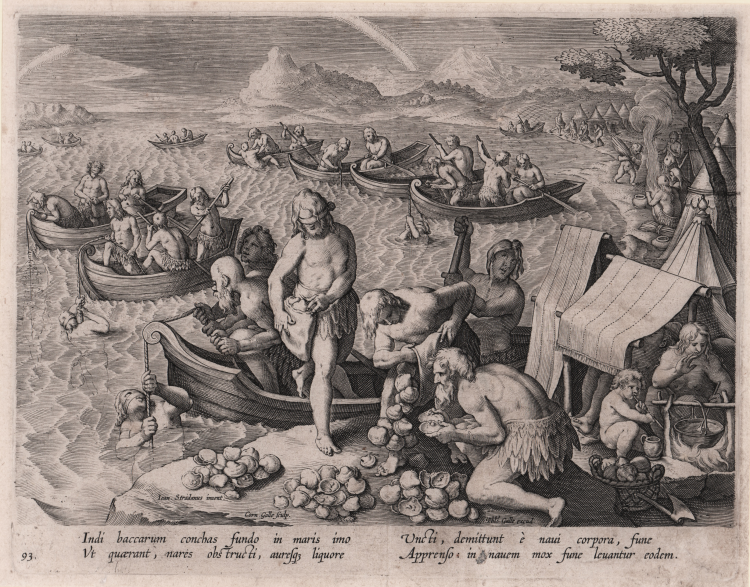




| Reference: | S12529 |
| Author | Cornelis GALLE |
| Year: | 1596 ca. |
| Measures: | 256 x 201 mm |



| Reference: | S12529 |
| Author | Cornelis GALLE |
| Year: | 1596 ca. |
| Measures: | 256 x 201 mm |
In the foreground, centre, men empty sacks of oyster shells containing pearls onto the shore, one emerging blindfolded from a boat; to right, women and children sit beneath an awning, tending a dish set over a fire; to left, Indians lower themselves on ropes from fishing boats to dive for pearls; the Indian encampment lines the shore on the right; in the distance a rainbow is seen.
Lettered within image: 'Ioan. Stradanus invent. / Corn. Galle sculp. / Phls Galle excud.', 'Indi baccarum conchas...eodem.'
Engraving, circa 1596.
From the "Venationes Ferarum, Avium, Piscium", after Jan van der Straet called Stradano or Stradanus, published by Philip Galle.
Once back in Antwerp, after a long trip to Italy, Stradano met Philip Galle, former pupil of Hieronumus Cock, who had recentely devouted himself to the art of printing. They planned together the realization of hunting subjects, inspired by the tapestry of the Villa in Poggio a Caiano. At the beginning, Galle realized a series of engravings without numbers, to which a second edition followed, with title page and 44 numbered plates. The sudden fame of his work convinced the printer to go on with his cooperation with Stradano, who realized new drawings with uncommon and exotic hunting subjects.
The new series was published first separately, then together with the first edition, forming a wide series of 104 plates, named Venationes Ferarum, Avium, Piscium, Pugnae. This work can be dated between 1578 (on the front page) and 1596. As for the tapestry of the Villa in Poggio a Caiano, the work is divided in three wide categories: terrestrial, air and water animals. At the beginning the hunting scenes have been engraved by Philip Galle himself, who then hired other members of his family and other assistants, among which Adriaen and Jan Collaert, Theodor and Cornelis Galle and Carolus de Mallery.
Magnificent work, printed on contemporary laid paper, trimmed to the platemark, in good condition.
Bibliografia
New Hollstein (Dutch & Flemish) / The New Hollstein: Dutch and Flemish etchings, engravings and woodcuts 1450-1700 (491.I); Baroni Vannucci 1997 / Jan van der Straet, detto Giovanni Stradano, flandrus pictor et inventor (693.93).
Cornelis GALLE (Anversa, 1576; Anversa, 29 Marzo 1650)
|
Engraver and publisher, son of Philip Galle. He was also a pupil of his father. In 1596 he visited Rome with his brother Theodor and remained there perhaps until 1610, when he became in Antwerp a member of the city’s Guild of St Luke. Shortly thereafter he founded a school of engraving in the city where many notable artists trained. The oeuvre of Cornelis Galle includes engravings after his own drawings as well as after compositions by other artists. During his stay in Rome, he made drawn copies of works by such artists as Raphael, Titian, Annibale Carracci, Giudo Reni and Jacopo Bassano, which he later used as preparatory designs for reproductive engravings after these Italian masters. Cornelis’s work for Rubens includes Judith Beheading Holofernes, known as the ‘Great Judith’, the Raising of the Cross, the Passion and the illustrations for the Vita beati P. Ignatii Loyolae. Cornelis Galle often engraved after the work of Anthony van Dyck (e.g. the Crucifixion). He also engraved works by numerous other Netherlandish artists including Marten de Vos, Hendrick Goltzius and Jacques Francuart; his engravings after the latter include the series of illustrations for the Pompa funebris optimi potentissimique Principis Alberti Pii (1623) by Erycius Puteanus (1574–1646). Cornelis Galle employed a traditional, dry engraving technique and style, typical of his father’s workshop. In the long term he could not produce work that satisfied Rubens’s requirements for reproductions of his paintings, and after 1610 the latter employed almost exclusively members of the Haarlem school for such work. However, Cornelis Galle retained Rubens’s patronage as an engraver of title-pages and book illustrations for Christoph Plantin.
|
Cornelis GALLE (Anversa, 1576; Anversa, 29 Marzo 1650)
|
Engraver and publisher, son of Philip Galle. He was also a pupil of his father. In 1596 he visited Rome with his brother Theodor and remained there perhaps until 1610, when he became in Antwerp a member of the city’s Guild of St Luke. Shortly thereafter he founded a school of engraving in the city where many notable artists trained. The oeuvre of Cornelis Galle includes engravings after his own drawings as well as after compositions by other artists. During his stay in Rome, he made drawn copies of works by such artists as Raphael, Titian, Annibale Carracci, Giudo Reni and Jacopo Bassano, which he later used as preparatory designs for reproductive engravings after these Italian masters. Cornelis’s work for Rubens includes Judith Beheading Holofernes, known as the ‘Great Judith’, the Raising of the Cross, the Passion and the illustrations for the Vita beati P. Ignatii Loyolae. Cornelis Galle often engraved after the work of Anthony van Dyck (e.g. the Crucifixion). He also engraved works by numerous other Netherlandish artists including Marten de Vos, Hendrick Goltzius and Jacques Francuart; his engravings after the latter include the series of illustrations for the Pompa funebris optimi potentissimique Principis Alberti Pii (1623) by Erycius Puteanus (1574–1646). Cornelis Galle employed a traditional, dry engraving technique and style, typical of his father’s workshop. In the long term he could not produce work that satisfied Rubens’s requirements for reproductions of his paintings, and after 1610 the latter employed almost exclusively members of the Haarlem school for such work. However, Cornelis Galle retained Rubens’s patronage as an engraver of title-pages and book illustrations for Christoph Plantin.
|